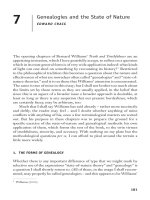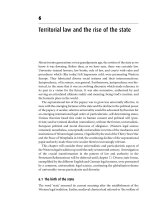Information, Entropy, and the Origin of Life
Bạn đang xem bản rút gọn của tài liệu. Xem và tải ngay bản đầy đủ của tài liệu tại đây (42.38 KB, 3 trang )
P1: KaF/KAA P2: KaF
0521829496c18.xml CY335B/Dembski 0 521 82949 6 April 2, 2004 21:6
18
Information, Entropy, and the Origin of Life
Walter L. Bradley
1.
introduction
Darwin’s theory of evolution and the development of the Second Law of
Thermodynamics by Clausius, Maxwell, Boltzmann, and Gibbs are two of
the three major scientific discoveries of the nineteenth century. Maxwell’s
field equations for electricity and magnetism are the third. The laws of
thermodynamics have had a unifying effect in the physical sciences similar
to that of the theory of evolution in the life sciences. What is intriguing
is that the predictions of one seem to contradict the predictions of the
other. The Second Law of Thermodynamics suggests a progression from
order to disorder, from complexity to simplicity, in the physical universe.
Yet biological evolution involves a hierarchical progression to increasingly
complex forms of living systems, seemingly in contradiction to the Second
Law of Thermodynamics.
In his great book The Nature of the Physical World, Arthur Eddington
(1928, 74) says, “If your theory is found to be against the second law of
thermodynamics, I can give you no hope; there is nothing for it but to col-
lapse in deepest humiliation.” But while nonliving systems dutifully obey
the Second Law of Thermodynamics, living systems seem to live in defiance
of it. In fact, this is one of the simplest ways of distinguishing living from
nonliving systems. Molton (1978, 147) defines life as “regions of order that
use energy to maintain their organization against the disruptive force of
entropy.”
But how is this possible? Lila Gatlin (1972, 1) says, “Life may be defined
operationally as an information processing system – a structural hierarchy of
functioning units – that has acquired through evolution the ability to store
and process the information necessary for its own accurate reproduction.” In
his classic book What Is Life? (1944), Erwin Schroedinger insightfully noted
that living systems are characterized by highly ordered, aperiodic structures
that survive by continually drawing “negentropy” from their environment
331
P1: KaF/KAA P2: KaF
0521829496c18.xml CY335B/Dembski 0 521 82949 6 April 2, 2004 21:6
332
Walter L. Bradley
and “feeding” on it. Schroedinger used the term “negentropy” to refer to
energy that was suitable for utilization by living systems, such as radiant
energy and energy-rich compounds. Schroedinger’s “highly ordered, ape-
riodic structures” we recognize today as the informational biopolymers of
life – DNA, RNA, and protein. A half-century later, Schroedinger’s seminal
insights have been confirmed.
If these scientists are right, the characteristic feature of life appears to
be its capacity, through the use of information, to survive and exist in
a nonequilibrium state, resisting the pull toward equilibrium that is de-
scribed by the Second Law of Thermodynamics. For them, the origin of
life is nothing more or less than the emergence of sufficient biological
information to enable a system of biopolymers to (1) store information,
(2) replicate with very occasional mistakes, and (3) “feed on negentropy.”
Unlike biological evolution, where it is fashionable to believe that there is
sufficient creative power in mutation combined with natural selection to ac-
count for the diversity of life in the biosphere, it is generally recognized
that the origin of life is one of the great unsolved mysteries in science
(Radetsky1992; Wade 2000).
At the heart of this mystery is the generation of the critical information
that is necessary to provide the three life functions just mentioned, in a
world in which the Second Law of Thermodynamics seems to naturally move
systems in the opposite direction, toward greater randomness. This chapter
will begin with a brief introduction to information theory, beginning with the
early work of Shannon (1948). This will allow us to quantify the information
in biopolymers – especially DNA, RNA, and protein, the molecules that are
essential for information storage, replication, and metabolism. Then we will
explore the concept of entropy and its ubiquitous increase in nature, usually
called the Second Law of Thermodynamics. This will allow us to understand
how living systems are able to sustain themselves against the downward pull
of the Second Law of Thermodynamics and how thermodynamics affects
the origin of information-rich, living systems. Finally, we will explore various
scenarios that have been proposed to account for the significant quantity of
information that is essential for the emergence of life in a world that so
naturally consumes rather than creates information.
2.
quantifying the information in biopolymers
Information theory was developed in 1948 by Claude Shannon of the Bell
Laboratories to address issues in communications. However, his approach
has found much broader application in many other areas, including the life
sciences. Shannon’s initial interest was in quantifying the transmission of
information, which he considered to be contained in a series of symbols, like
letters in an alphabet. For reasons clearly explained in his book, Shannon
P1: KaF/KAA P2: KaF
0521829496c18.xml CY335B/Dembski 0 521 82949 6 April 2, 2004 21:6
Information, Entropy, and the Origin of Life
333
chose to quantify the information “i” per register (or position) in his message
as
i = K log W (1a)
where W is the total number of symbols or letters being used to create the
message. If each symbol or letter used in his message is equally probable,
then the probability of any given symbol is given by p
i
= 1/WorW= 1/p
i
,
and
i = K log (1/p
i
) =−K log p
i
(1b)
In order to express this information in bits, let K = 1 and use log to the base
2, or log
2
. Equation 1b becomes
i =−log
2
p
i
(2)
If the probabilities of each symbol are not equal, then Equation 2 becomes
i =−
p
i
log
2
p
i
(3)
Shannon Information in DNA. Information in living systems is stored in the
DNA molecule, which has four bases called nucleotides that effectively serve
as an alphabet of four letters: A-adenine, T-thymine, C-cytosine, and G-
guanine. In E. coli bacteria, these bases appear equally often, such that p
i
=
1
/
4
for each one. Thus, using Equation 2, we may calculate the information
per nucleotide to be
i =−log
2
(
1
/
4
) = 2 bits (4)
Since there are 4×10
6
nucleotides in the DNA of E. coli bacteria (Gatlin
1972, 34), the total amount of Shannon information would be
I
s
= N • i = 4 × 10
6
× 2 = 8 × 10
6
bits of information (5)
The total Shannon information “I
s
” represents the number of binary deci-
sions that must be made in order to get any sequence of base nucleotides in
DNA. It is simple (at least in principle) to calculate the number of different
messages (or sequences) that one might create in a polynucleotide with 4 ×
10
6
bases such as the polynucleotide in E. coli. The total number of unique
messages “M” that can be formed from 4 × 10
6
binary decisions is given by
M = 2
Is
= 2
8,000,000
= 10
2,400,000
(6)
For comparison, the typing on this page requires only 10
4
bits of informa-
tion, so the E. coli DNA has information equivalent to 8×10
6
/10
4
= 800
pages like this one. It must be emphasized that each of the 10
2,400,000
alter-
native sequences or messages in Equation 6 contains the same amount of
structural, or syntactic, information – namely, 8,000,000 bits. Yet only a few of









